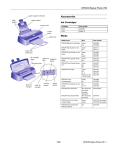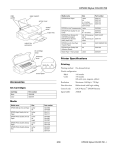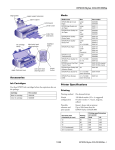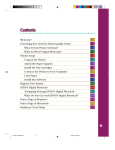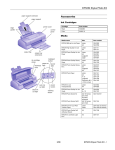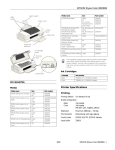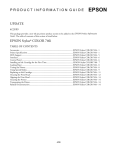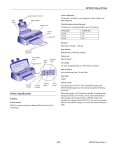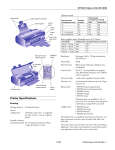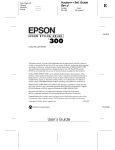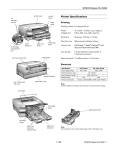Download Epson Stylus COLOR 300 Specifications
Transcript
EPSON Stylus COLOR 300 Accessories paper support paper thickness lever power switch edge guides Ink Cartridge Use only the ink cartridge specified in the table below with the EPSON Stylus COLOR 300. Use EPSON ink cartridges within six months of installing them and before the expiration date on the package. left edge guide lock lever Cartridge Part number Color ink cartridge (CMYK) S020138 Media sheet feeder printer cover control panel load/eject button cleaning button paper out light ink out light Media name Size Part number EPSON 360 dpi Ink Jet Paper Letter A4 S041060 S041059 EPSON High Quality Ink Jet Paper Letter A4 S041111 S041117 EPSON Photo Quality Ink Jet Paper Letter Legal A4 S041062 S041067 S041061 EPSON Photo Quality Glossy Paper Letter A4 S041124 S041126 EPSON Photo Quality Glossy Film Letter A4 A6 S041072 S041071 S041107 EPSON Ink Jet Transparencies Letter A4 S041064 S041063 EPSON Photo Paper/ Cards 4 × 6 inches S041134 EPSON Photo Quality Ink Jet Cards 8 × 10 inches A6 S041122 S041054 EPSON Photo Quality Self Adhesive Sheets A4 S041106 power light adjust lever Printer Specifications ink cartridge clamp Printing User Replaceable Parts User Replaceable Part Parts Price List Name Part Number Paper support Paper support 1022997 Printer cover Printer cover 1035802 Logo Logo plate 1036165 Printing method On-demand ink jet Nozzle configuration Monochrome (black) 31 nozzles Color (cyan, magenta, yellow) 33 nozzles (11 per color × 3) Print speed (text) 200 characters per second (cps) in LQ mode at 10 cpi Print speed (graphics) 200 inches per second (ips) at 360 dpi Printable columns (text) 80 columns at 10 cpi Printable columns (graphics) 2880 dots at 360 dpi 5/98 EPSON Stylus COLOR 300 - 1 EPSON Stylus COLOR 300 Resolution EPSON 720 dpi mode* 360 × 360 dpi mode 180 × 180 dpi mode * In EPSON 720 dpi mode, prints at 360 × 360 dpi on a matrix of 720 dots per inch using smaller dots than the 360 × 360 dpi mode. Dots are printed in an alternating pattern in which horizontal and vertical dots are non-contiguous. Contiguous printing of dots is available only on the diagonal plane. The result is a significantly denser dot pattern, finer detail, and smoother edges than output produced by 360 × 360 dpi printing. Print direction Bidirectional with logic seeking for text and graphics. Control codes ESC/P Raster Input buffer 25KB Fonts Bitmap LQ and EPSON Courier (10 cpi) Character table ASCII; includes 37 character codes (A to Z and 0 to 9), one space code, and one symbol code (#) Paper Paper type Size Paper types Thickness Weight Single sheets Letter (8.5 × 11 inches) Legal (8.5 × 14 inches) Half Letter/Statement (5.5 × 8.5 inches) Executive (7.25 × 10.5 inches) A4 (210 × 297 mm) B5 (182 × 257 mm) Plain bond paper and special ink jet papers distributed by EPSON 0.003 to 0.004 inch (0.08 to 0.11 mm) 17 to 24 lb (64 to 90 g/m2) Envelopes No. 10: 9.5 × 4.1 inches (240 × 104 mm) DL: 8.7 × 4.3 inches (220 × 110 mm) Plain bond paper or air mail paper 0.006 to 0.02 inch (0.16 to 0.52 mm) 12 to 24 lb (45 to 90 g/m2) Glossy paper Letter (8.5 × 11 inches) A4 (210 × 297 mm) Glossy paper distributed by EPSON 0.0066 to 0.0070 inch (0.17 to 0.18 mm) — Transparencies and glossy film Letter (8.5 × 11 inches) A4 (210 × 297 mm) A6 (105 × 148 mm, glossy film only) Transparencies and glossy film distributed by EPSON 0.005 to 0.006 inch (0.13 to 0.15 mm) — Photo paper 4 × 6 inches (102 × 152 mm) Special photo paper distributed by EPSON — — Index cards 8 × 10 inches (203 × 254 mm) A6 (105 × 148 mm) Ink jet cards distributed by EPSON 0.0091 inch (0.23 mm) maximum 50 lb (188 g/m2) Self adhesive sheets A4 (210 × 297 mm) Self adhesive sheets distributed by EPSON 0.0079 inch (0.2 mm) maximum — Printable areas Note: Since the quality of any particular brand or type of paper may be changed by the manufacturer at any time, EPSON cannot attest to the quality of any non-EPSON brand or type of paper. Always test samples of paper stock before purchasing large quantities or printing large jobs. Single sheets, transparencies, index cards, and self adhesive sheets A Poor quality paper may reduce print quality and cause paper jams and other problems. If you encounter problems, switch to a higher grade of paper. B-L B-R Ink jet paper, envelopes, glossy film, glossy paper, transparencies, and self adhesive sheets are usable only under these conditions: Temperature: 59 to 77 °F (15 to 25 °C) Humidity: 40 to 60% RH C A: The minimum top margin is 0.12 inch (3.0 mm). When loading multiple sheets of EPSON Photo Quality Glossy Film, the minimum top margin is 1.2 inches (30 mm). B-L: The minimum left margin is 0.12 inch (3.0 mm). B-R: The minimum right margin is 0.12 inch (3.0 mm); except for Letter and Legal size paper, which are 0.38 inch (10.0 mm). C: The minimum bottom margin is 0.55 inch (14.0 mm). EPSON Photo Quality Glossy Film and Photo Quality Self Adhesive Sheets should be stored under these conditions: Temperature: 59 to 86 °F (15 to 30 °C) Humidity: 20 to 60% RH 2 - EPSON Stylus COLOR 300 5/98 EPSON Stylus COLOR 300 Dimensions Envelopes A B-L Printing Width: 15.6 inches (397 mm) Depth: 12.6 inches (319 mm) Height: 10.6 inches (269 mm) B-R C A: B-L: B-R: C: Storage Width: 15.6 inches (397 mm) Depth: 8.1 inches (206 mm) Height: 6.4 inches (162 mm) The minimum top margin is 0.12 inch (3.0 mm). The minimum left and right margins are 0.12 inch (3.0 mm). The minimum right margin is as follows: 1.32 inches (33.8 mm) for No. 10 envelopes. 0.54 inch (13.8 mm) for DL envelopes. The minimum bottom margin is 0.55 inch (14.0 mm). Weight 8.6 lb (3.9 kg) without the ink cartridge Electrical Ink Cartridge Specification 120V Model 220−240V Model Input voltage range 103.5 to 132V 198 to 264V Rated frequency range 50 to 60 Hz Input frequency range 49.5 to 60.5 Hz Specification Color ink cartridge (S020138) Colors Cyan, Magenta, Yellow, and Black Print capacity* 220 pages (A4, 360 dpi, 5% duty each color) 450 pages (A4, monochrome text printing only) Cartridge life 2 years from production date, if unopened Within 6 months after opening package at 77 °F (25 °C) Note: Check the label on the back of the printer for your printer’s voltage. Storage temperature –22 to 104 °F (–30 to 40 °C) 1 month at 104 °F (40 °C) Environmental Transit temperature –22 to 140 °F (–30 to 60 °C) 1 month at 104 °F (40 °C) 120 hours at 140 °F (60 °C) Freezing temperature** 21.2 °F (–6 °C) Dimensions 1.81 (W) × 2.22(D) × 1.52 (H) inches 45.9 (W) × 56.5 (D) × 38.5 (H) mm Rated current 0.5A Power consumption Approx. 15W (ISO 10561 Letter Pattern) Temperature Operation: 50 to 95 °F (10 to 35 °C) Storage: –4 to 140 °F (–20 to 60 °C), stored in shipping container 1 month at 104 °F (40 °C) 120 hours at 140 °F (60 °C) Humidity Operation: 20 to 80% RH Storage: 5 to 85% RH (in shipping container, without condensation) * The print capacity may vary, depending on how often you clean the print head. ** The ink cartridge thaws and is usable after approximately 3 hours at 77 °F (25 °C). 0.3A Safety Approvals Caution: To ensure good results, use genuine EPSON ink cartridges. Other products may cause damage to your printer not covered by EPSON’s warranty. Do not use an ink cartridge if the date on the package has expired. Safety standards UL 1950 with D3, CSA C22.2 950 with D3 EMC FCC part 15 subpart B class B, CSA C108.8 class B Parallel Interface Mechanical Forward channel Paper feed method Data format: Friction 8-bit parallel, IEEE-1284 compatibility mode Paper path Sheet feeder, rear entry Synchronization: STROBE Sheet feeder capacity About 100 sheets of 17 lb (64 g/m2) paper Handshake timing: BUSY Signal level: TTL compatible Connector: 36-pin Centronics connector or equivalent Total print volume 10,000 pages (Letter or A4) 5/98 pulse and ACKNLG signals EPSON Stylus COLOR 300 - 3 EPSON Stylus COLOR 300 Reverse channel Ink Out Transmission mode: IEEE-1284 Nibble mode Adaptable connector: 57-30360 Amphenol connector or equivalent Synchronization: Refer to the IEEE-1284 specification. Handshaking: Refer to the IEEE-1284 specification. Signal level: IEEE-1284 Level 1 device Data transmission timing: Refer to the IEEE-1284 specification. Extensibility request: V When the V Ink Out light flashes, your ink supply is low. Make sure you have a replacement cartridge. When the V Ink Out light comes on, the ink cartridge is empty and you need to replace it. The V Ink Out light also comes on if an ink cartridge is not installed or not installed properly. Paper Out S When the S Paper Out light is on, your paper is out or is loaded incorrectly. Load paper in the sheet feeder, then press the E Load/Eject button to turn off the light and resume printing. The printer responds to the extensibility request in the affirmative when the request is 00H or 04H, which means: 00H: Request Nibble mode of reverse channel transfer 04H: Request device ID in Nibble mode of reverse channel transfer When the S Paper Out light flashes, there is a paper jam. Remove the paper from the sheet feeder and then reload it. If the light continues to flash, turn off the printer, remove the paper from the sheet feeder, and gently pull out all jammed paper. Control Panel Initialization Buttons Cleaning T Load/Eject E Moves the print head to the ink cartridge replacement position if pressed for 3 seconds while the V Ink Out light is flashing or on. Returns the print head to its home position after ink cartridge replacement. Performs print head cleaning if pressed for 3 seconds when the V Ink Out light is off. The printer can be initialized (returned to a fixed set of conditions) in these ways: Hardware initialization interface: pin 31 goes LOW. Software initialization P Loads or ejects paper if pressed and released within 2 seconds. Resumes printing if pressed after a paper out error. The P Power light is on when the printer is on. When the P Power light flashes, the printer is receiving data, or you are replacing the ink cartridge, charging the ink supply system, or cleaning the print head. It may also flash with other lights during printer error conditions. 4 - EPSON Stylus COLOR 300 Software sends the ESC @ (initialize the printer) command. The last panel settings are kept. Both initialization methods reset the font according to the default settings selected using the control panel. However, ESC @ does not initialize the printer mechanism, clear the input data buffer, or clear the user-defined character set. Lights Power The printer is turned on. The printer receives an INIT signal from the parallel 5/98 EPSON Stylus COLOR 300 6. Lower the ink cartridge into the holder with the label face up and the arrow mark pointing toward the back of the printer. Installing an Ink Cartridge for the First Time 1. Turn on the printer. The P Power and V Ink Out lights come on. 2. Hold down the R Cleaning button for three seconds. The P Power light starts flashing, and the print head moves slightly left to the ink cartridge replacement position. Caution: To avoid damaging the printer, do not move the print head by hand. 3. Open the printer cover. 4. Lift up the ink cartridge clamp as far as it goes. Then remove the protective material from the cartridge holder. 7. Press down the ink cartridge clamp until it locks in place. Caution: Do not open the clamp again until you replace the ink cartridge; otherwise, the cartridge may become unusable. ink cartridge clamp 8. Press the R Cleaning button. The printer moves the print head to the home (far right) position and charges the ink delivery system. Charging takes a few minutes and, during this time, the P Power light continues to flash. Caution: Do not turn off the printer while the P Power light is flashing; otherwise, the ink delivery system will not be completely charged. Warning: If ink gets on your hands, wash them thoroughly with soap and water. If ink gets in your eyes, flush them immediately with water. Note: Even if you do not press the R Cleaning button, the printer moves the print head back to its home position about 60 seconds after you replace the cartridge. 5. Open the ink cartridge package. Next remove only the yellow portion of the tape seal from the top of the cartridge. Don’t remove the white portion. 9. Close the printer cover. remove yellow part Replacing the Ink Cartridge When the Ink Runs Out don’t remove white part color ink cartridge S020138 When the V Ink Out light flashes, the ink cartridge is low on ink. This is a good time to make sure you have a new cartridge. When the light stays on, the cartridge is empty and you need to replace it as described below. Caution: You must completely remove the yellow tape seal from the top of the cartridge; installing the cartridge with any portion of it still on will permanently damage the cartridge. Also, do not remove the clear seal from the bottom of the cartridge; ink will leak out. Note: If the expiration date of your ink cartridge has passed or if you are having print quality problems, you may need to replace the ink cartridge even though it still contains ink and the V Ink Out light is off. See the next section, “Replacing the Ink Cartridge Before the Ink Runs Out,” for instructions. 5/98 EPSON Stylus COLOR 300 - 5 EPSON Stylus COLOR 300 To replace the ink cartridge when the V Ink Out light is flashing or on, follow the steps below. remove yellow part Caution: To ensure good results, use genuine EPSON cartridges and do not refill them. Other products may cause damage to your printer not covered by EPSON’s warranty. don’t remove white part color ink cartridge S020138 Leave the old cartridge installed in the printer until you are ready to replace it with a new one. Caution: You must completely remove the yellow tape seal from the top of the cartridge; installing the cartridge with any portion of it still on will permanently damage the cartridge. Also, do not remove the clear seal from the bottom of the cartridge; ink will leak out. 1. Make sure the printer is turned on and not printing, and the V Ink Out light is flashing or on. Then open the printer cover. 2. Hold down the R Cleaning button for three seconds. The P Power light starts flashing, and the print head moves slightly left to the ink cartridge replacement position. (The print head automatically returns to the home position after about 60 seconds if you don’t begin the installation procedure.) 6. Lower the new ink cartridge into the holder with the label face up and the arrow mark pointing toward the back of the printer. Caution: To avoid damaging the printer, do not move the print head by hand. Once you open the ink cartridge clamp or remove an ink cartridge, the ink cartridge becomes unusable. Do not reinstall it even if it still contains ink; otherwise, it may damage the printer or cause the ink level sensor to malfunction. 3. Lift up the ink cartridge clamp as far as it goes. The ink cartridge rises partly out of the ink cartridge holder. 7. Press down the ink cartridge clamp until it locks in place. ink cartridge clamp Caution: Do not open the clamp again until you replace the ink cartridge; otherwise, the cartridge may become unusable. 8. Press the R Cleaning button. The printer moves the print head back to the home position and charges the ink delivery system. Charging takes about one minute, and during this time, the P Power light continues to flash. Warning: If ink gets on your hands, wash them thoroughly with soap and water. If ink gets in your eyes, flush them immediately with water. Caution: Do not turn off the printer while the P Power light is flashing; otherwise, the ink delivery system will not be completely charged. 4. Lift the cartridge out of the printer and dispose of it properly. Note: Even if you do not press the R Cleaning button, the printer moves the print head back to its home position about 60 seconds after you replace the cartridge. 5. Open the ink cartridge package. Next remove only the yellow portion of the tape seal from the top of the cartridge. Don’t remove the white portion. 6 - EPSON Stylus COLOR 300 9. Close the printer cover. 5/98 EPSON Stylus COLOR 300 6. Lower the new ink cartridge into the holder with the label face up and the arrow mark pointing toward the back of the printer. Replacing the Ink Cartridge Before the Ink Runs Out If the expiration date of your ink cartridge has passed, you need to replace the ink cartridge even though it still contains ink and the V Ink Out light is off. You may also need to do so if you are having print quality problems that persist even after you try cleaning and aligning the print head as described later in this update. Note: Be sure to use up ink cartridges by the expiration date marked on the cartridge label; otherwise, the ink may become unusable. To replace an ink cartridge when the V Ink Out light is off, follow the steps below. 7. Press down the ink cartridge clamp until it locks in place. Caution: Once you open the ink cartridge clamp or remove an ink cartridge, the ink cartridge becomes unusable. Do not reinstall it even if it still contains ink; otherwise, it may damage the printer or cause the ink level sensor to malfunction. Caution: Do not open the clamp again until you replace the ink cartridge; otherwise, the cartridge may become unusable. 8. Press the E Load/Eject button. The printer moves the print head back to the home position and charges the ink delivery system. Charging takes about one minute, and during this time, the P Power light continues to flash. 1. Make sure the printer is turned on and not printing, and the V Ink Out light is off. Then open the printer cover. 2. Hold down the E Load/Eject button for three seconds. The P Power light starts flashing, and the print head moves slightly left to the ink cartridge replacement position. Caution: Do not turn off the printer while the P Power light is flashing; otherwise, the ink delivery system will not be completely charged. Caution: To avoid damaging the printer, do not move the print head by hand. Note: Even if you do not press the E Load/Eject button, the printer moves the print head back to its home position about 60 seconds after you replace the cartridge. 3. Lift up the ink cartridge clamp. Warning: If ink gets on your hands, wash them thoroughly with soap and water. If ink gets in your eyes, flush them immediately with water. 9. Close the printer cover. 4. Lift the ink cartridge out of the printer and dispose of it properly. Using Plain Paper and Special Media 5. Open the ink cartridge package and remove only the yellow portion of the tape seal from the top of the cartridge. Don’t remove the white portion. Whether you print on plain paper or special media, you need to load it according to the guidelines in the table below. You must also select the correct Media Type setting in your printer software to match the media you loaded. Caution: You must completely remove the yellow tape seal from the top of the cartridge; installing the cartridge with any portion of it still on will permanently damage the cartridge. Also, do not remove the clear seal from the bottom of the cartridge; ink will leak out. Load plain paper and special media into the printer printable side up, and set the paper thickness and adjust levers as described after the table. For complete paper loading instructions, see the User’s Guide. 5/98 EPSON Stylus COLOR 300 - 7 EPSON Stylus COLOR 300 Setting the Thickness Lever When you load media with this name. . . Load this many sheets in the sheet feeder. . . Then select this Media Type setting in your printer software. . . Plain paper (single sheets) Up to the arrow mark on the left edge guide (about 100 sheets); for Legal size paper, halfway up to the arrow mark (about 50 sheets) Envelopes* Up to 10 EPSON 360 dpi Ink Jet Paper Up to the arrow mark on the left edge guide; for Legal size paper, halfway up to the arrow mark 360 dpi Ink Jet Paper Up to the arrow mark on the left edge guide; for Legal size paper, halfway up to the arrow mark Photo Quality Ink Jet Paper EPSON Special Coated Paper for 360 dpi Printing EPSON High Quality Ink Jet Paper EPSON Photo Quality Ink Jet Paper Set the thickness lever according to the media type as shown below. Plain Paper thick paper plain paper EPSON Special Coated Paper for 720 dpi Printing EPSON Photo Quality Ink Jet Cards EPSON 720 dpi Index Cards Up to 30 index cards with a support sheet beneath the cards Load short edge first EPSON Photo Quality Self Adhesive Sheets 1 sheet at a time EPSON Photo Quality Glossy Paper 1 sheet at a time with a support sheet beneath it EPSON Photo Paper Up to 20 sheets with a support sheet beneath the stack Load short edge first with larger perforated margin at the top EPSON Photo Quality Glossy Film** 1 sheet at a time for best results; use with a support sheet or a sheet of plain paper EPSON High Quality Glossy Paper 1 sheet at a time for best results; use with a support sheet or a sheet of plain paper EPSON Ink Jet Transparencies Up to 30 transparencies with a support sheet beneath the stack Photo Quality Ink Jet Paper Paper type Plain paper Standard paper, coated paper, glossy paper, glossy film, and transparencies Thick paper Envelopes, index cards, self adhesive sheets, and photo paper Setting the Adjust Lever Set the adjust lever according to the media type as shown below. Photo Quality Glossy Paper Photo Quality Glossy Film Ink Jet Transparencies Lever position Paper type 0 Standard paper, coated paper, index cards, glossy paper, glossy film, and transparencies + Envelopes Note: If the ink on your printout smears, set the adjust lever to the + position. * Load envelopes top edge first with the flap side down. ** To load multiple sheets, place up to 30 sheets in the sheet feeder and set the minimum top margin to 1.2 inches (30 mm). You must load A6 size sheets one at a time. 8 - EPSON Stylus COLOR 300 Lever position 5/98 EPSON Stylus COLOR 300 Testing the Printer Cleaning the Print Head You can run a printer self test to check the operation of the printer. If you encounter a printing problem, running a self test can help you determine whether the problem comes from the printer itself or some other source. If your printed image is unexpectedly light or faint, or dots are missing from the image, you may need to clean the print head. This unclogs the nozzles so they can deliver ink properly. Cleaning the print head uses ink, so clean it only if print quality declines. You can use either of the following: ❏ If the test results are satisfactory, the problem probably lies in the printer software settings, application settings, interface cable, or computer. ❏ The Head Cleaning utility in your printer software (when the printer is connected directly to the computer) ❏ If the test page doesn’t print correctly (for example, if a part of the printed lines is missing), you may have a problem with your printer. The problem may be a clogged ink nozzle, misaligned print head, or bad ink cartridge. See “Cleaning the Print Head,” “Aligning the Print Head,” or “Replacing the Ink Cartridge Before the Ink Runs Out,” in this update. ❏ The printer’s control panel buttons (when using DOS, when your printer is part of a network, or when you don’t want to use the Head Cleaning utility) Note: To save ink, use the Nozzle Check utility in your printer software to run a nozzle check and confirm that the print head needs to be cleaned. To run a nozzle check, access the printer software window and click the Utility tab to display the Utility menu. Click the Nozzle Check icon, then click Next. (See the next section for instructions on examining the nozzle check pattern.) Follow these steps to test the printer: 1. Make sure both the printer and computer are turned off. 2. Disconnect the interface cable (and ground connector, if necessary) from the back of the printer. When the V Ink Out light is flashing or on, you cannot clean the print head; first replace the ink cartridge as described earlier in this update. 3. Make sure that paper is loaded in the sheet feeder. Caution: Use paper that is at least 7.17 inches (182 mm) wide so ink doesn’t spray onto the platen. Using the Head Cleaning Utility Follow these steps to run the Head Cleaning utility from a Windows computer connected directly to the printer: 4. Hold down the E Load/Eject button and turn on the printer; then release the button. This prints the nozzle check, including the printer’s ROM version, the ink counter code, and a nozzle check pattern. The test is printed in color. 1. Make sure the printer is turned on and not printing. Also make sure the V Ink Out light is off. 2. Access the printer software window. 3. Click the Utility tab at the top of the window. You see the Utility menu. Caution: Do not turn off the printer while it is printing the nozzle check. 4. Click the Head Cleaning icon. 5. Follow the instructions on the screen to clean the print head. Cleaning the print head takes about one minute, during which the P Power light flashes. Note: If the page doesn’t print, turn off the printer. Then repeat this step, holding down the E Load/Eject button a bit longer. Caution: Never turn off the printer while the P Power light is flashing. The nozzle check pattern is shown below: ROM version ink counter code 6. When the P Power light stops flashing, you need to run a nozzle check to test the print quality and reset the cleaning cycle. Make sure paper is loaded in the printer and click Print nozzle check pattern. Then click Next. 5. To end the self test, turn off the printer after it finishes printing one page. 7. See the next section for instructions on examining the nozzle check pattern. Note: You can run a character test by following the steps above and holding the R Cleaning button instead of the E Load/Eject button. The printer prints a page of letters and numbers. 8. If your print quality has not improved, repeat the steps above. You may need to do this two or three times. 5/98 EPSON Stylus COLOR 300 - 9 EPSON Stylus COLOR 300 Using the Control Panel Aligning the Print Head Follow these steps to clean the print head using the control panel buttons: If your printouts contain misaligned vertical lines, you may need to align the print head. 1. Make sure the printer is turned on and not printing. Also make sure the V Ink Out light is off. Using the Print Head Alignment Utility 2. Hold down the R Cleaning button for three seconds. The P Power light starts flashing and the printer begins cleaning the print head. Cleaning the print head takes about one minute. Caution: Never turn off the printer while the flashing. If you’re using a Windows computer connected directly to the printer, you can align the print head using the Print Head Alignment utility in your printer software. Follow these steps: 1. Turn on the printer and make sure that paper is loaded in the sheet feeder. P Power light is Caution: Use paper that is at least 8.3 inches (210 mm) wide so ink doesn’t spray onto the platen. Note: If you accidentally pressed the R Cleaning button while the V Ink Out light is flashing or on, the ink cartridge replacement procedure starts. If you don’t want to replace the ink cartridge at this time, press the R Cleaning button again to return the print head to its home position. 2. Access the printer software window. 3. Click the Utility tab at the top of the window. You see the Utility menu. 4. Click the Print Head Alignment icon. 3. When the P Power light stops flashing, you need to print a page to test the print quality and reset the cleaning cycle. If you’re using DOS or your printer is part of a network, open an application and print a document containing black and color data. 5. Follow the instructions on the screen to print an alignment test page and select the correct alignment. Related Documentation If your printer is connected directly to your computer, run a nozzle check. To do this, access the printer software window and click the Utility tab to display the Utility menu. Click the Nozzle Check icon, then click Next. (See the next section for instructions on examining the nozzle check pattern.) TM-SC300 EPSON Stylus COLOR 300 Service Manual PL-SC300 EPSON Stylus COLOR 300 Parts Price List 4. If your print quality has not improved, repeat the steps above. You may need to do this two or three times. CPD 6707 EPSON Stylus COLOR 300 User’s Guide Examining the Nozzle Check Pattern CPD 6708 EPSON Stylus COLOR 300 Start Here guide Examine the nozzle check pattern you print. It should look something like this, with the right side of the pattern colored cyan, magenta, and yellow: Each staggered horizontal and straight vertical line should be complete, with no gaps in the dot pattern. If any dots are missing, clean the print head again, as explained in the previous sections. 10 - EPSON Stylus COLOR 300 5/98











